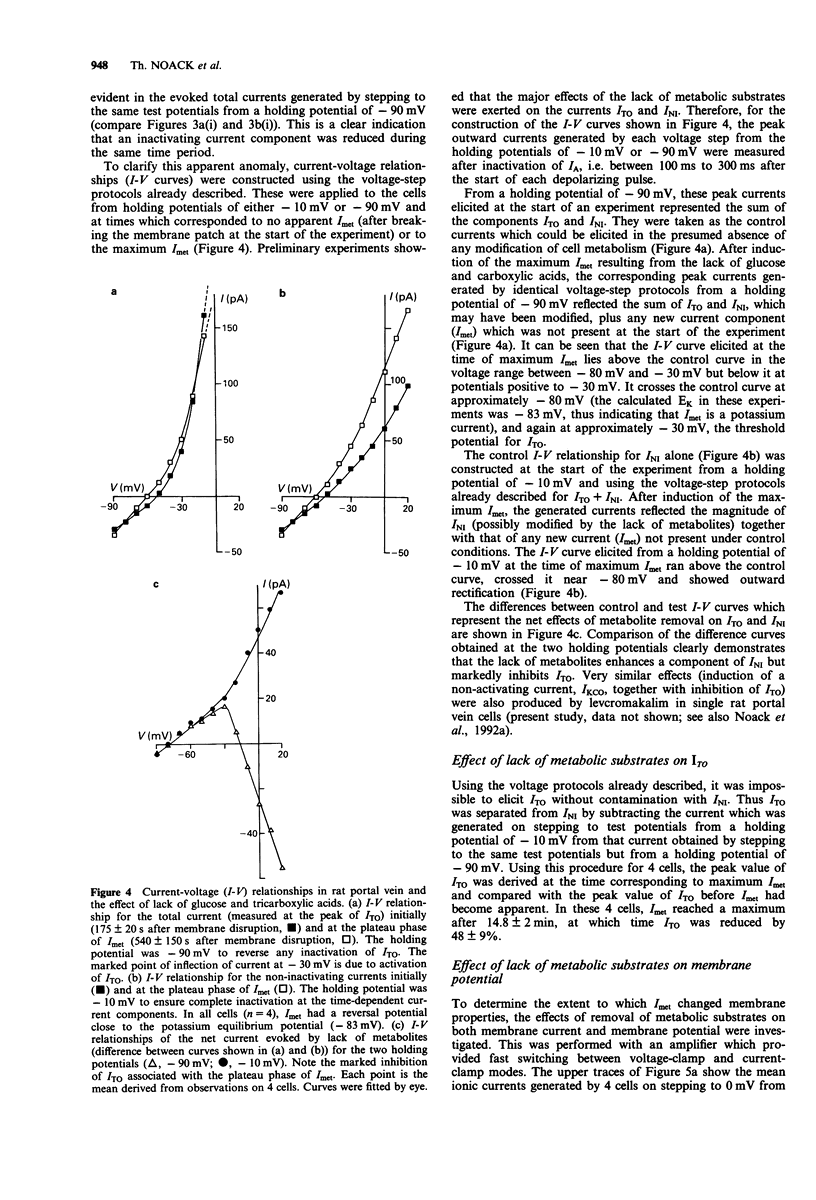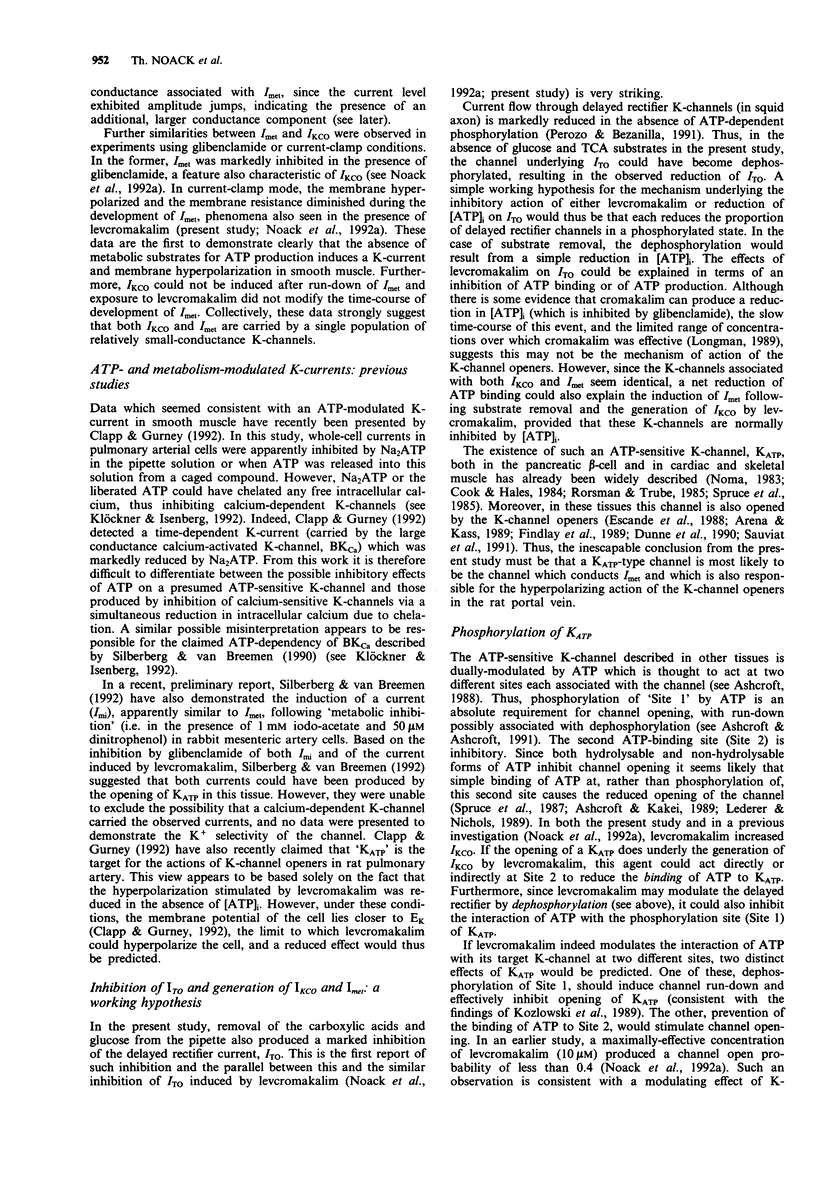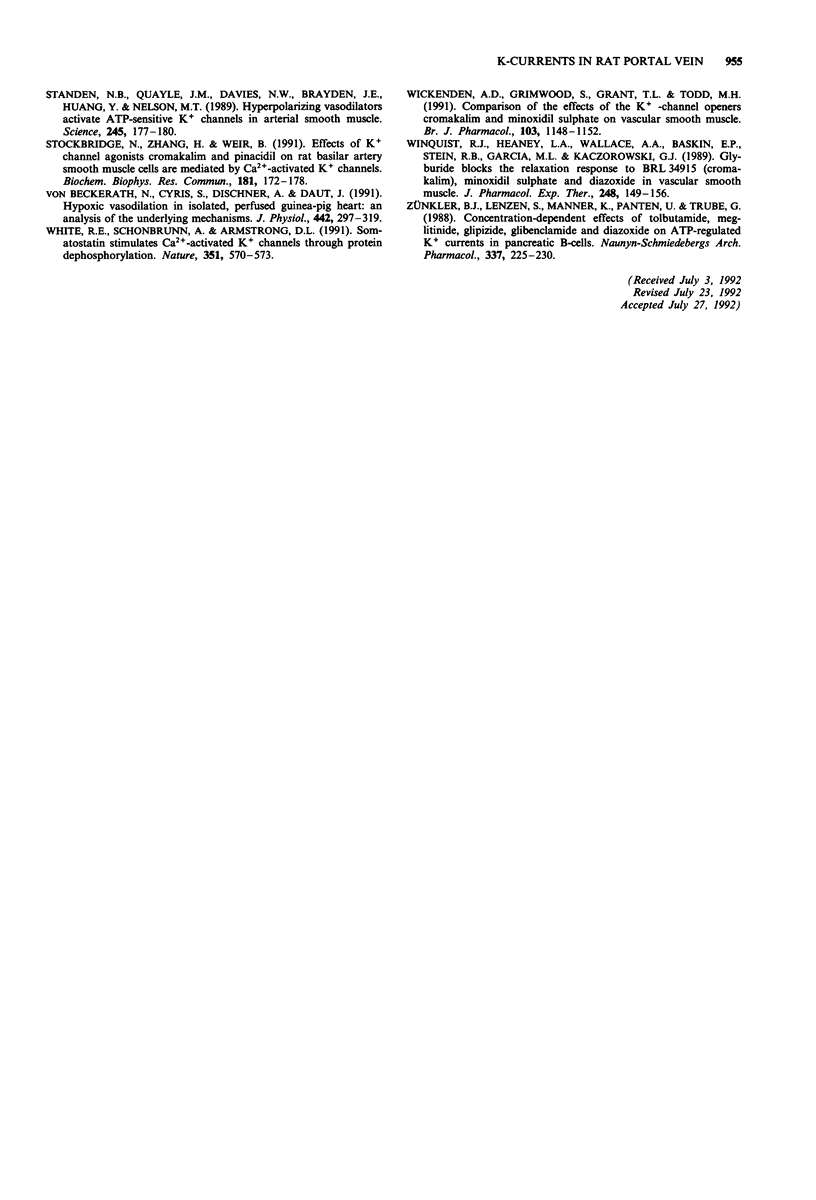Abstract
1. The effects of levcromakalim and of adenosine 5'-triphosphate (ATP) depletion on membrane potential and ionic currents were studied in freshly-dispersed smooth muscle cells of rat portal vein by use of combined voltage- and current-clamp techniques. 2. Levcromakalim (1 microM) induced a glibenclamide-sensitive, non-inactivating K-current (IKCO) and simultaneously inhibited the slow, transient outward, delayed rectifier K-current (ITO). Levcromakalim also hyperpolarized the portal vein cells by approximately 20 mV. 3. Reduction of intracellular ATP by removal of glucose and carboxylic acids from the recording pipette and of glucose from the bath fluid, induced a slowly-developing, non-inactivating and glibenclamide-sensitive K-current (Imet) within 60-300 s after breaking the membrane patch. Imet reached peak amplitude after 300-900 s, remained at a plateau for 200-800 s and then slowly ran down. At the peak of Imet, the cells were hyperpolarized by approximately 20 mV and their input conductance was increased by 42%. 4. At the time of maximum development of Imet, the delayed rectifier current, ITO, was reduced by 48%. 5. In the absence of glucose and carboxylic acids, addition of 1 microM free ATP to the recording pipette almost doubled the magnitude of Imet. At a holding potential of -10 mV, Imet was increased from 124 +/- 11 pA to 228 +/- 54 pA whereas the time-course of development and run-down of Imet was unaffected. 6. During the development and after the run-down of Imet, levcromakalim (1-10 microM) failed to induce IKCO. 7. Stationary fluctuation analysis of the current noise associated with Imet revealed a unitary conductance of between 10-20 pS in a physiological potassium gradient. A second contaminating current with an underlying unitary conductance of approximately 150 pS remained after Imet had run down. 8. It is concluded that IKCO induced by levcromakalim and Imet are carried by the same population of relatively small conductance, glibenclamide-sensitive K-channels. The open state of these is increased by procedures designed to lower intracellular ATP concentrations. 9. The simultaneous inhibition of the delayed rectifier current (ITO) by both levcromakalim and during the development of Imet is highly significant. It suggests that levcromakalim could modify the interaction of ATP with sites linked to more than one type of K-channel. This results in the opening of those channels which underlie IKCO (and which are normally inhibited by ATP binding) together with the modulation of phosphorylation-dependent channels such as those which underlie ITO.
Full text
PDF










Selected References
These references are in PubMed. This may not be the complete list of references from this article.
- Arena J. P., Kass R. S. Enhancement of potassium-sensitive current in heart cells by pinacidil. Evidence for modulation of the ATP-sensitive potassium channel. Circ Res. 1989 Aug;65(2):436–445. doi: 10.1161/01.res.65.2.436. [DOI] [PubMed] [Google Scholar]
- Ashcroft F. M. Adenosine 5'-triphosphate-sensitive potassium channels. Annu Rev Neurosci. 1988;11:97–118. doi: 10.1146/annurev.ne.11.030188.000525. [DOI] [PubMed] [Google Scholar]
- Ashcroft F. M., Kakei M. ATP-sensitive K+ channels in rat pancreatic beta-cells: modulation by ATP and Mg2+ ions. J Physiol. 1989 Sep;416:349–367. doi: 10.1113/jphysiol.1989.sp017765. [DOI] [PMC free article] [PubMed] [Google Scholar]
- Ashcroft S. J., Ashcroft F. M. Properties and functions of ATP-sensitive K-channels. Cell Signal. 1990;2(3):197–214. doi: 10.1016/0898-6568(90)90048-f. [DOI] [PubMed] [Google Scholar]
- Beech D. J., Bolton T. B. Properties of the cromakalim-induced potassium conductance in smooth muscle cells isolated from the rabbit portal vein. Br J Pharmacol. 1989 Nov;98(3):851–864. doi: 10.1111/j.1476-5381.1989.tb14614.x. [DOI] [PMC free article] [PubMed] [Google Scholar]
- Beech D. J., Bolton T. B. Two components of potassium current activated by depolarization of single smooth muscle cells from the rabbit portal vein. J Physiol. 1989 Nov;418:293–309. doi: 10.1113/jphysiol.1989.sp017841. [DOI] [PMC free article] [PubMed] [Google Scholar]
- Bueding E., Bülbring E., Gercken G., Hawkins J. T., Kuriyama H. The effect of adrenaline on the adenosine otriphosphate and creatine phosphate content of intestinal smooth muscle. J Physiol. 1967 Nov;193(1):187–212. doi: 10.1113/jphysiol.1967.sp008351. [DOI] [PMC free article] [PubMed] [Google Scholar]
- Clapp L. H., Gurney A. M. ATP-sensitive K+ channels regulate resting potential of pulmonary arterial smooth muscle cells. Am J Physiol. 1992 Mar;262(3 Pt 2):H916–H920. doi: 10.1152/ajpheart.1992.262.3.H916. [DOI] [PubMed] [Google Scholar]
- Cook D. L., Hales C. N. Intracellular ATP directly blocks K+ channels in pancreatic B-cells. Nature. 1984 Sep 20;311(5983):271–273. doi: 10.1038/311271a0. [DOI] [PubMed] [Google Scholar]
- Daut J., Maier-Rudolph W., von Beckerath N., Mehrke G., Günther K., Goedel-Meinen L. Hypoxic dilation of coronary arteries is mediated by ATP-sensitive potassium channels. Science. 1990 Mar 16;247(4948):1341–1344. doi: 10.1126/science.2107575. [DOI] [PubMed] [Google Scholar]
- Dunne M. J., Illot M. C., Peterson O. H. Interaction of diazoxide, tolbutamide and ATP4- on nucleotide-dependent K+ channels in an insulin-secreting cell line. J Membr Biol. 1987;99(3):215–224. doi: 10.1007/BF01995702. [DOI] [PubMed] [Google Scholar]
- Dunne M. J., Yule D. I., Gallacher D. V., Petersen O. H. Comparative study of the effects of cromakalim (BRL 34915) and diazoxide on membrane potential, [Ca2+]i and ATP-sensitive potassium currents in insulin-secreting cells. J Membr Biol. 1990 Mar;114(1):53–60. doi: 10.1007/BF01869384. [DOI] [PubMed] [Google Scholar]
- Edwards G., Weston A. H. Potassium channel openers and vascular smooth muscle relaxation. Pharmacol Ther. 1990;48(2):237–258. doi: 10.1016/0163-7258(90)90082-d. [DOI] [PubMed] [Google Scholar]
- Escande D., Cavero I. K+ channel openers and 'natural' cardioprotection. Trends Pharmacol Sci. 1992 Jul;13(7):269–272. doi: 10.1016/0165-6147(92)90083-i. [DOI] [PubMed] [Google Scholar]
- Escande D., Thuringer D., Leguern S., Cavero I. The potassium channel opener cromakalim (BRL 34915) activates ATP-dependent K+ channels in isolated cardiac myocytes. Biochem Biophys Res Commun. 1988 Jul 29;154(2):620–625. doi: 10.1016/0006-291x(88)90184-2. [DOI] [PubMed] [Google Scholar]
- Fabiato A. Computer programs for calculating total from specified free or free from specified total ionic concentrations in aqueous solutions containing multiple metals and ligands. Methods Enzymol. 1988;157:378–417. doi: 10.1016/0076-6879(88)57093-3. [DOI] [PubMed] [Google Scholar]
- Findlay I., Deroubaix E., Guiraudou P., Coraboeuf E. Effects of activation of ATP-sensitive K+ channels in mammalian ventricular myocytes. Am J Physiol. 1989 Nov;257(5 Pt 2):H1551–H1559. doi: 10.1152/ajpheart.1989.257.5.H1551. [DOI] [PubMed] [Google Scholar]
- Fosset M., De Weille J. R., Green R. D., Schmid-Antomarchi H., Lazdunski M. Antidiabetic sulfonylureas control action potential properties in heart cells via high affinity receptors that are linked to ATP-dependent K+ channels. J Biol Chem. 1988 Jun 15;263(17):7933–7936. [PubMed] [Google Scholar]
- Fuhrmann G. F., Schwarz W., Kersten R., Sdun H. Effects of vanadate, menadione and menadione analogs on the Ca2+-activated K+ channels in human red cells. Possible relations to membrane-bound oxidoreductase activity. Biochim Biophys Acta. 1985 Nov 7;820(2):223–234. doi: 10.1016/0005-2736(85)90116-6. [DOI] [PubMed] [Google Scholar]
- Hamill O. P., Marty A., Neher E., Sakmann B., Sigworth F. J. Improved patch-clamp techniques for high-resolution current recording from cells and cell-free membrane patches. Pflugers Arch. 1981 Aug;391(2):85–100. doi: 10.1007/BF00656997. [DOI] [PubMed] [Google Scholar]
- Hamilton T. C., Weir S. W., Weston A. H. Comparison of the effects of BRL 34915 and verapamil on electrical and mechanical activity in rat portal vein. Br J Pharmacol. 1986 May;88(1):103–111. doi: 10.1111/j.1476-5381.1986.tb09476.x. [DOI] [PMC free article] [PubMed] [Google Scholar]
- Hermsmeyer R. K. Pinacidil actions on ion channels in vascular muscle. J Cardiovasc Pharmacol. 1988;12 (Suppl 2):S17–S22. doi: 10.1097/00005344-198812002-00005. [DOI] [PubMed] [Google Scholar]
- Hu S. L., Kim H. S., Okolie P., Weiss G. B. Alterations by glyburide of effects of BRL 34915 and P 1060 on contraction, 86Rb efflux and the maxi-K+ channel in rat portal vein. J Pharmacol Exp Ther. 1990 May;253(2):771–777. [PubMed] [Google Scholar]
- Kajioka S., Kitamura K., Kuriyama H. Guanosine diphosphate activates an adenosine 5'-triphosphate-sensitive K+ channel in the rabbit portal vein. J Physiol. 1991 Dec;444:397–418. doi: 10.1113/jphysiol.1991.sp018885. [DOI] [PMC free article] [PubMed] [Google Scholar]
- Kajioka S., Oike M., Kitamura K. Nicorandil opens a calcium-dependent potassium channel in smooth muscle cells of the rat portal vein. J Pharmacol Exp Ther. 1990 Sep;254(3):905–913. [PubMed] [Google Scholar]
- Klöckner U., Isenberg G. ATP suppresses activity of Ca(2+)-activated K+ channels by Ca2+ chelation. Pflugers Arch. 1992 Jan;420(1):101–105. doi: 10.1007/BF00378648. [DOI] [PubMed] [Google Scholar]
- Klöckner U., Isenberg G. Calcium currents of cesium loaded isolated smooth muscle cells (urinary bladder of the guinea pig). Pflugers Arch. 1985 Dec;405(4):340–348. doi: 10.1007/BF00595686. [DOI] [PubMed] [Google Scholar]
- Kozlowski R. Z., Hales C. N., Ashford M. L. Dual effects of diazoxide on ATP-K+ currents recorded from an insulin-secreting cell line. Br J Pharmacol. 1989 Aug;97(4):1039–1050. doi: 10.1111/j.1476-5381.1989.tb12560.x. [DOI] [PMC free article] [PubMed] [Google Scholar]
- Lederer W. J., Nichols C. G. Nucleotide modulation of the activity of rat heart ATP-sensitive K+ channels in isolated membrane patches. J Physiol. 1989 Dec;419:193–211. doi: 10.1113/jphysiol.1989.sp017869. [DOI] [PMC free article] [PubMed] [Google Scholar]
- Noack T., Deitmer P., Edwards G., Weston A. H. Characterization of potassium currents modulated by BRL 38227 in rat portal vein. Br J Pharmacol. 1992 Jul;106(3):717–726. doi: 10.1111/j.1476-5381.1992.tb14400.x. [DOI] [PMC free article] [PubMed] [Google Scholar]
- Noack T., Edwards G., Deitmer P., Greengrass P., Morita T., Andersson P. O., Criddle D., Wyllie M. G., Weston A. H. The involvement of potassium channels in the action of ciclazindol in rat portal vein. Br J Pharmacol. 1992 May;106(1):17–24. doi: 10.1111/j.1476-5381.1992.tb14286.x. [DOI] [PMC free article] [PubMed] [Google Scholar]
- Noma A. ATP-regulated K+ channels in cardiac muscle. Nature. 1983 Sep 8;305(5930):147–148. doi: 10.1038/305147a0. [DOI] [PubMed] [Google Scholar]
- Okabe K., Kajioka S., Nakao K., Kitamura K., Kuriyama H., Weston A. H. Actions of cromakalim on ionic currents recorded from single smooth muscle cells of the rat portal vein. J Pharmacol Exp Ther. 1990 Feb;252(2):832–839. [PubMed] [Google Scholar]
- Perozo E., Bezanilla F. Phosphorylation of K+ channels in the squid giant axon. A mechanistic analysis. J Bioenerg Biomembr. 1991 Aug;23(4):599–613. doi: 10.1007/BF00785813. [DOI] [PubMed] [Google Scholar]
- Post J. M., Stevens R. J., Sanders K. M., Hume J. R. Effect of cromakalim and lemakalim on slow waves and membrane currents in colonic smooth muscle. Am J Physiol. 1991 Feb;260(2 Pt 1):C375–C382. doi: 10.1152/ajpcell.1991.260.2.C375. [DOI] [PubMed] [Google Scholar]
- Quast U., Cook N. S. Moving together: K+ channel openers and ATP-sensitive K+ channels. Trends Pharmacol Sci. 1989 Nov;10(11):431–435. doi: 10.1016/S0165-6147(89)80003-3. [DOI] [PubMed] [Google Scholar]
- Reinhart P. H., Chung S., Martin B. L., Brautigan D. L., Levitan I. B. Modulation of calcium-activated potassium channels from rat brain by protein kinase A and phosphatase 2A. J Neurosci. 1991 Jun;11(6):1627–1635. doi: 10.1523/JNEUROSCI.11-06-01627.1991. [DOI] [PMC free article] [PubMed] [Google Scholar]
- Ribalet B., Ciani S., Eddlestone G. T. ATP mediates both activation and inhibition of K(ATP) channel activity via cAMP-dependent protein kinase in insulin-secreting cell lines. J Gen Physiol. 1989 Oct;94(4):693–717. doi: 10.1085/jgp.94.4.693. [DOI] [PMC free article] [PubMed] [Google Scholar]
- Rorsman P., Trube G. Glucose dependent K+-channels in pancreatic beta-cells are regulated by intracellular ATP. Pflugers Arch. 1985 Dec;405(4):305–309. doi: 10.1007/BF00595682. [DOI] [PubMed] [Google Scholar]
- Sauviat M. P., Ecault E., Faivre J. F., Findlay I. Activation of ATP-sensitive K channels by a K channel opener (SR 44866) and the effect upon electrical and mechanical activity of frog skeletal muscle. Pflugers Arch. 1991 Apr;418(3):261–265. doi: 10.1007/BF00370524. [DOI] [PubMed] [Google Scholar]
- Silberberg S. D., van Breemen C. A potassium current activated by lemakalim and metabolic inhibition in rabbit mesenteric artery. Pflugers Arch. 1992 Jan;420(1):118–120. doi: 10.1007/BF00378653. [DOI] [PubMed] [Google Scholar]
- Silberberg S. D., van Breemen C. An ATP, calcium and voltage sensitive potassium channel in porcine coronary artery smooth muscle cells. Biochem Biophys Res Commun. 1990 Oct 30;172(2):517–522. doi: 10.1016/0006-291x(90)90703-p. [DOI] [PubMed] [Google Scholar]
- Spruce A. E., Standen N. B., Stanfield P. R. Studies of the unitary properties of adenosine-5'-triphosphate-regulated potassium channels of frog skeletal muscle. J Physiol. 1987 Jan;382:213–236. doi: 10.1113/jphysiol.1987.sp016364. [DOI] [PMC free article] [PubMed] [Google Scholar]
- Spruce A. E., Standen N. B., Stanfield P. R. Voltage-dependent ATP-sensitive potassium channels of skeletal muscle membrane. Nature. 1985 Aug 22;316(6030):736–738. doi: 10.1038/316736a0. [DOI] [PubMed] [Google Scholar]
- Standen N. B., Quayle J. M., Davies N. W., Brayden J. E., Huang Y., Nelson M. T. Hyperpolarizing vasodilators activate ATP-sensitive K+ channels in arterial smooth muscle. Science. 1989 Jul 14;245(4914):177–180. doi: 10.1126/science.2501869. [DOI] [PubMed] [Google Scholar]
- Stockbridge N., Zhang H., Weir B. Effects of K+ channel agonists cromakalim and pinacidil on rat basilar artery smooth muscle cells are mediated by Ca(++)-activated K+ channels. Biochem Biophys Res Commun. 1991 Nov 27;181(1):172–178. doi: 10.1016/s0006-291x(05)81397-x. [DOI] [PubMed] [Google Scholar]
- White R. E., Schonbrunn A., Armstrong D. L. Somatostatin stimulates Ca(2+)-activated K+ channels through protein dephosphorylation. Nature. 1991 Jun 13;351(6327):570–573. doi: 10.1038/351570a0. [DOI] [PubMed] [Google Scholar]
- Wickenden A. D., Grimwood S., Grant T. L., Todd M. H. Comparison of the effects of the K(+)-channel openers cromakalim and minoxidil sulphate on vascular smooth muscle. Br J Pharmacol. 1991 May;103(1):1148–1152. doi: 10.1111/j.1476-5381.1991.tb12315.x. [DOI] [PMC free article] [PubMed] [Google Scholar]
- Winquist R. J., Heaney L. A., Wallace A. A., Baskin E. P., Stein R. B., Garcia M. L., Kaczorowski G. J. Glyburide blocks the relaxation response to BRL 34915 (cromakalim), minoxidil sulfate and diazoxide in vascular smooth muscle. J Pharmacol Exp Ther. 1989 Jan;248(1):149–156. [PubMed] [Google Scholar]
- Zünkler B. J., Lenzen S., Männer K., Panten U., Trube G. Concentration-dependent effects of tolbutamide, meglitinide, glipizide, glibenclamide and diazoxide on ATP-regulated K+ currents in pancreatic B-cells. Naunyn Schmiedebergs Arch Pharmacol. 1988 Feb;337(2):225–230. doi: 10.1007/BF00169252. [DOI] [PubMed] [Google Scholar]
- von Beckerath N., Cyrys S., Dischner A., Daut J. Hypoxic vasodilatation in isolated, perfused guinea-pig heart: an analysis of the underlying mechanisms. J Physiol. 1991 Oct;442:297–319. doi: 10.1113/jphysiol.1991.sp018794. [DOI] [PMC free article] [PubMed] [Google Scholar]


